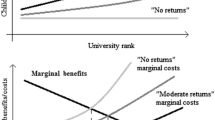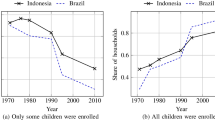Abstract
In this paper, we consider two types of population policies observed in practice: birth limits and birth taxes. We find that both achieve very similar equilibrium solutions if tax revenue finances lump-sum transfers. By reducing fertility and promoting growth, both birth policies may achieve higher welfare than conventional education subsidies financed by income taxes. A birth tax for education subsidies can achieve the first-best solution. The welfare gain of the first-best policy may be equivalent to a massive 10–50% rise in income, depending on the degree of human capital externalities and the elasticity of intertemporal substitution.
Similar content being viewed by others
References
Altonji JG, Hayashi F, Kotlikoff LJ (1997) Parental altruism and inter vivos transfers: theory and evidence. J Polit Econ 105(6):1121–1166
Banister J (1987) China’s changing population. Stanford University Press, Stanford
Barro RJ, Becker GS (1989) Fertility choices in a model of economic growth. Econometrica 57(2):481–501
Barro RJ, Sala-i-Martin X (1995) Economic growth. MIT, Cambridge
Becker GS, Murphy KM, Tamura R (1990) Human capital, fertility, and economic growth. J Polit Econ 98(5):S12–S37
Boyer GR (1989) Malthus was right after all: poor relief and birth rates in Southeastern England. J Polit Econ 97(1):93–114
Ciccone A, Peri G (2006) Identifying human-capital externalities: theory with applications. Rev Econ Stud 73(2):381–412
Cigno A, Pettini A (2002) Taxing family size and subsidizing child-specific commodities? J Public Econ 84(1):75–90
Cigno A, Rosati FC (1992) The effects of financial and social security on saving and fertility behavior in Italy. J Popul Econ 5(4):319–341
Doepke M (2004) Accounting for fertility decline during the transition to growth. J Econ Growth 9(3):347–383
Ehrlich I, Lui F (1991) Intergenerational trade, longevity and the value of life extension. J Polit Econ 99(5):1029–1059
Galor O, Moav O (2002) Natural selection and the origin of economic growth. Q J Econ 117(4):1133–1191
Galor O, Weil D (2000) Population, technology, and growth: from Malthusian stagnation to the demographic transition and beyond. Am Econ Rev 90(4):806–828
Greenwood J, Hercowitz Z, Huffman GW (1988) Investment, capacity utilization, and the real business cycle. Am Econ Rev 78(3):402–417
Guo ZG, Zhang EL, Gu BC, Wang F (2003) Diversity of China’s fertility policy by policy fertility. Popul Res 27(5):1–10
Heckman J (2003) China’s investment in human capital. Econ Dev Cult Change 51(4):795–804
Lagerlof N (2003) From Malthus to modern growth: can epidemics explain the three regimes? Int Econ Rev 44(2):755–777
Laitner J, Thomas JF (1996) New evidence on altruism: a study of TIAA-CREF retirees. Am Econ Rev 86(4):893–908
Malthus TR (1807) A letter to Samuel Whitbread...on his proposed bill for the amendment of the poor law, 2nd edn. Johnson, London (Reprinted in 1970 in The Pamphlets of Thomas Robert Malthus. Kelley, New York)
Malthus TR (1872) An essay on the principles of population, 7th edn. Reeves and Turner, London (Reprinted in 1914. Dent, London)
Mankiw NG, Romer D, Weil DN (1992) A contribution to the empirics of economic growth. Q J Econ 107(2):407–437
Mirrlees JA (1972) Population policy and the taxation of family size. J Public Econ 1(2):169–198
Morand OF (1999) Endogenous fertility, income distribution, and growth. J Econ Growth 4(3):331–349
Moretti E (2004) Workers’ education, spillovers and productivity: evidence from plant-level production functions. Am Econ Rev 94(3):656–690
Scotese CA, Wang P (1995) can government enforcement permanently alter fertility? The case of China. Econ Inq 33(4):552–570
Sen A (2000) Development as freedom. Anchor, New York
Solon G (1999) Intergenerational mobility in the labor market. In: Ashenfelter H, Card D (eds) Handbook of labor economics, vol 3A. Elsevier, Amsterdam, pp 1761–1800
Tamura R (1991) Income convergence in an endogenous growth model. J Polit Econ 99(3):522–540
Tamura R (2000) Growth, fertility and human capital: a survey. Span Econ Rev 2(3):183–229
Tamura R (2002) Human capital and the switch from agriculture to industry. J Econ Dyn Control 27(2):207–242
Tamura R (2006) Human capital and economic development. J Dev Econ 79(1):26–72
Whittington LA, Alm J, Peters HE (1990) Fertility and the personal exemption: implicit pronatalist policy in the united states. Am Econ Rev 80(3):545–555
Whyte MK, Gu SZ (1987) Popular response to China’s fertility transition. Popul Dev Rev 13(3):471–493
World Bank (2002) World development indicators. World Bank, Washington, DC
World Bank (2004) World development indicators. World Bank, Washington, DC
Zhang J (1999) Transition to market economics in an endogenous growth model with altruistic agents. Scand J Econ 101(1):11–31
Zhang J (2002) Urbanization, population transition, and growth. Oxf Econ Pap 54(1):91–117
Zhang J (2003) Optimal debt, endogenous fertility, and human capital externalities in a model with altruistic bequests. J Public Econ 87(7):1825–1835
Zhang J, Casagrande R (1998) Fertility, growth, and flat-rate taxation for education subsidies. Econ Lett 60(2):209–216
Zhang J, Zhang J (2004) How does social security affect economic growth: evidence from cross-country data. J Popul Econ 17(3):473–500
Zhang J, Zhang J, Lee R (2001) Mortality decline and long-run economic growth. J Public Econ 80(3):485–507
Author information
Authors and Affiliations
Corresponding author
Additional information
Responsible editor: Alessandro Cigno
Rights and permissions
About this article
Cite this article
Shi, Y., Zhang, J. On high fertility rates in developing countries: birth limits, birth taxes, or education subsidies?. J Popul Econ 22, 603–640 (2009). https://doi.org/10.1007/s00148-008-0212-9
Received:
Accepted:
Published:
Issue Date:
DOI: https://doi.org/10.1007/s00148-008-0212-9




